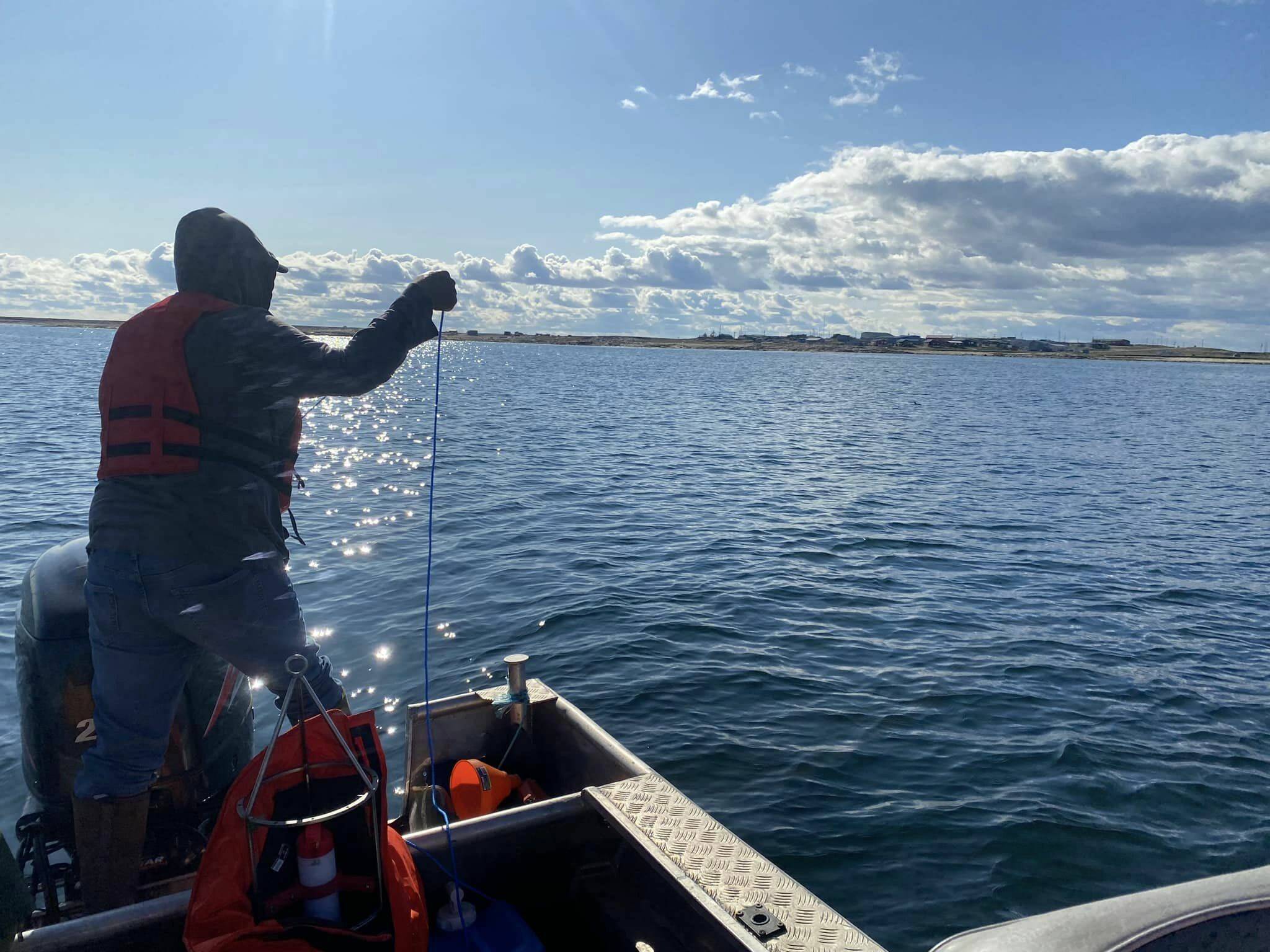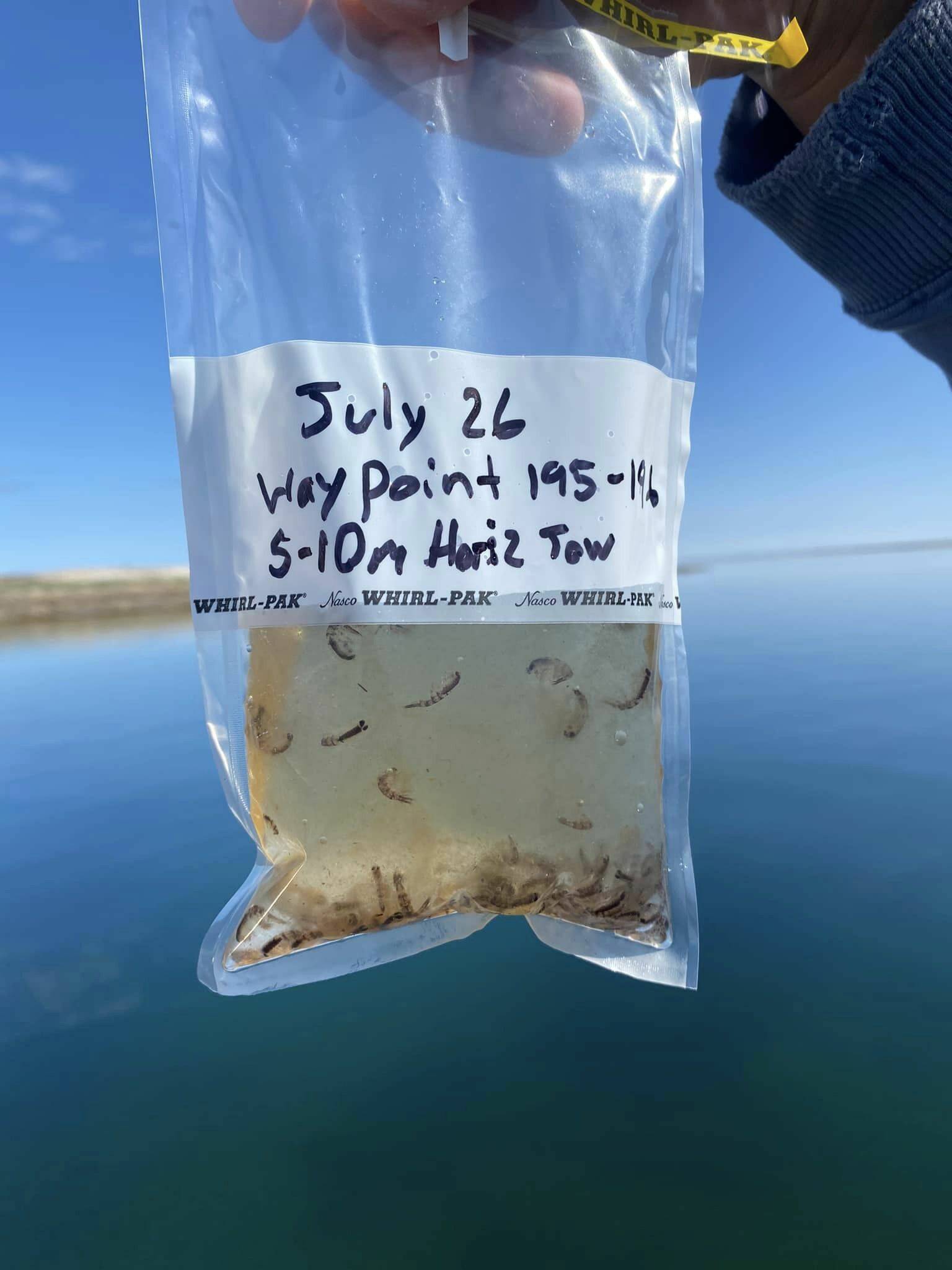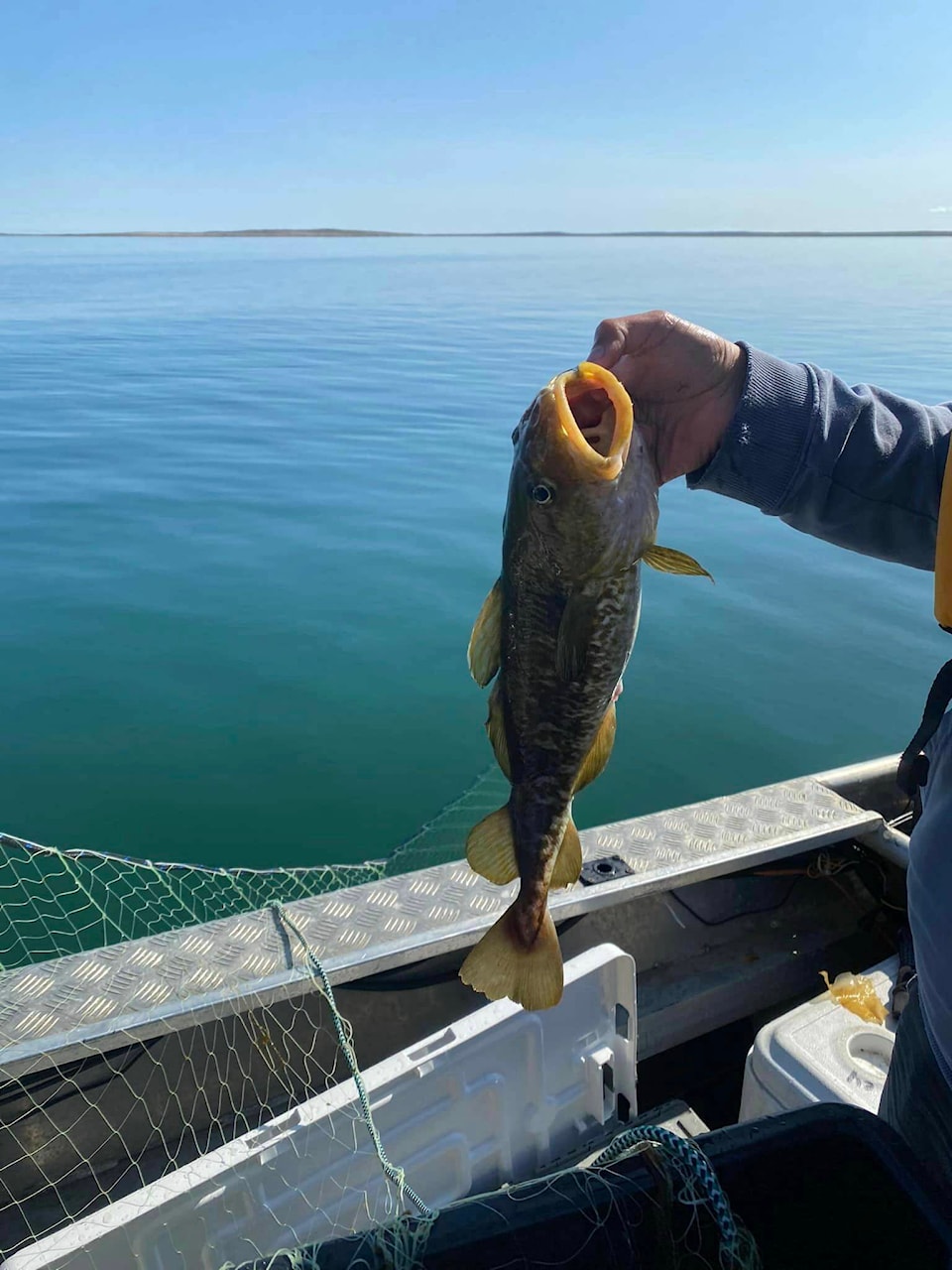Fisheries and Oceans Canada is building up a backlog of data from community work as it supports the Southampton Island Area of Interest designation and potential marina protected area one day in the future.
Researchers have been in Chesterfield Inlet this summer training locals to collect data, part of a project that has also been taking place in Rankin Inlet since last summer and Kinngait before that.
“We kind of have a recipe of standardized things that we collect, but when we meet the HTO and request their support and introduce the project, we ty to tailor it to what they’re interested in,” explained Darcy McNicholl, aquatic science biologist with Fisheries and Oceans Canada.
Her team spent a week training technicians in Chesterfield Inlet to collect plankton, gather benthic samples and generate ocean profile data. After the scientists head south, research continues throughout the summer with technicians going out about once a week.
And in Chesterfield Inlet, hunters were particularly interested in the potential for a scallop fishery, said McNicholl. In Rankin Inlet, they wanted salinity data.
The Arctic Coast team from Fisheries and Oceans Canada did some robot video work underwater in Chesterfield Inlet while they were in town but found no evidence of scallops.
“There’s a huge amount of kelp outside of Chesterfield,” though, said McNicholl, adding that it was unexpected.
Kinngait’s data goes back to 2020, and McNicholl said salmon are starting to show up in the region so her team is watching the interaction between them and char.
In underwater video work in Rankin Inlet, her team collected footage of sea anemones and some different species of fish that McNicholl didn’t think had been documented before.
Asked whether establishing a scallop fishery could conflict with the goals to turn a portion of the region into a marine protected area, McNicholl said the two can go hand in hand and be worked out through discussions.
“A marine protected area doesn’t mean that there can’t be any fishing or commercial activities,” said McNicholl, adding that her background is science, not policy. “If Chesterfield wanted to develop the scallop fishery, it’s still possible.”
ᐃᒪᕐᒥᐅᑕᓕᕆᔨᒃᑯᑦ ᑲᓇᑕᒥ ᑲᑎᑦᑎᕗᑦ ᐱᔭᕇᖅᑕᐅᓯᒪᖏᑦᑐᓂᒃ ᐃᓗᓕᐅᔪᒥᒃ ᓄᓇᓕᐅᑉ ᐱᓕᕆᐊᒃᓴᖏᓐᓂ ᐃᑲᔪᕐᓂᖏᓐᓂ ᓱᒡᓕᐊᑯᑕ ᓄᓇᖓᓂ ᐃᓱᒪᒋᔭᐅᓪᓗᓂ ᐊᑐᖅᑕᐅᓛᕐᓂᐊᕐᓂᕐᒥᓂ ᐊᒻᒪᓗ ᑎᑯᐊᖅᑕᐅᓯᒪᓪᓗᓂ ᑕᕆᐅᖅ ᐃᒪᖅ ᓴᐳᑎᓯᒪᓇᓱᖕᓂᖅ ᐃᓗᖅ ᐊᑐᓛᖅᑐᒥ ᓯᕗᓂᑦᑎᓐᓂ.
ᖃᐅᔨᓴᖅᑎᑦ ᐃᒡᓗᓕᒐᕐᔪᖕᒦᑐᑦ ᐊᐅᔭᐅᔪᒥ ᐱᓕᒻᒪᒃᓴᐃᓪᓗᑎᒃ ᓄᓇᓕᖕᒥᐅᓂᒃ ᐊᕗᓂᖅ ᐃᓗᓕᓂᒃ, ᐃᓚᒐ ᐱᓕᕆᐊᖅ ᐊᑐᖅᑕᐅᖕᒥᔪᖅ ᑲᖏᖅᖠᓂᕐᒥ ᐊᐅᕙᓂ ᐊᒻᒪᓗ ᑭᙵᐃᓂ ᑭᖑᓪᓕᕐᒥ.
”ᐱᓯᒪᕐᓚᐅᔭᖅᑐᒍ ᒪᓕᒐᒥᑦ ᐊᕿᒃᓯᒪᔪᑎᒥ ᐊᕙᑕᑦᑎᓐᓂ, ᑭᓯᐊᓂ ᑲᑎᖃᑎᖃᕋᖓᑦᑕ HTO ᐊᒻᒪᓗ ᐱᔪᒪᔪᑎ ᐃᑲᔪᑎᓄᑦ ᐊᒻᒪᓗ ᐃᓕᑦᑎᕕᒋᓗᑎᒍ ᐱᓕᕆᐊᒃᓴᖅ, ᑐᑭᓯᑎᓐᓇᓱᕈᓘᔭᖅᐸᒃᑕᕗᑦ ᐱᔪᒪᓂᖏᓐᓄ,” ᐅᖃᖅᐳᖅ ᑕᐅᓯ ᒥᓂᑯ, ᐃᒪᕐᒥᐅᑕᓄ ᖃᐅᔨᓴᖅᑎ ᐃᒪᕐᒥᐅᑕᓕᕆᔨᒃᑯᓐᓄ ᑲᓇᑕᒥ.
ᐃᖃᓇᐃᔭᖅᑎᖃᑎᖏᑦ ᐱᓇᓱᐊᕈᓯᖅ ᐱᓕᒻᒪᒃᓴᐃᓚᐅᖅᑐᑦ ᐱᓕᕆᔨᓂ ᐃᒡᓗᖠᒐᕐᔪᖕᒥ ᐊᕗᖅᑐᑦ ᐃᒪᕐᒥᐅᑕᒃᓴᔭᒥᒃ ᖃᐅᔨᓴᕈᑎᒃᓴᓂᒃ ᐊᒻᒪᓗ ᐃᖏᕋᑎᓐᓂᖅ ᐃᒪᕐᒥ ᐊᕗᖅᑕᐅᔪᑦ. ᐱᐊᓂᒃᑯᑎ ᖃᐅᔨᓴᖅᑎᑦ ᖃᓗᓈᓄᑦ, ᖃᐅᔨᓴᕐᓂᖅ ᑲᔪᓯᕗᖅ ᐊᐅᔭ ᐃᖃᓇᐃᔭᖅᑎᖃᖅᖢᑎ ᐊᐅᓚᑲᑕᒃᑎᑦ ᐱᓇᓱᐊᕈᓯᑕᒪᖅ.
ᐃᒡᓗᓕᒐᕐᔪᒥ, ᐊᖑᓇᓱᒃᑎᑦ ᐱᔪᒪᓂᖃᕐᓂᖅᓴᐅᓚᐅᖅᑐᑦ ᐱᓕᕆᐊᖑᔪᒥ ᐊᒧᒪᔪᖅᑕᕐᓂᖅ, ᐅᖃᖅᐳᖅ ᒪᒃᓂᑯ. ᑲᖏᖅᖠᓂᕐᒥ, ᐱᔪᒪᓚᐅᖅᑐᑦ ᖃᐅᔨᓴᕐᓂᐊᖅᑕᒥᓂᒃ ᐃᒪᐃᓐᓴᐅ ᐃᓗᓕᖓᓂ.
ᐅᑭᐅᖅᑕᖅᑐᒥ ᐃᓴᕐᒥᐅᑕᓕᕆᔨᑦ ᐃᖃᓗᓕᕆᔨᒃᑯᓐᓂ ᑲᓇᑕᒥ ᐊᔾᔨᓕᐅᕆᒪᐅᖅᑐᑦ ᐊᐅᓚᔫᒃᑯᑦ ᐃᒪᐅᑉ ᐊᑕᓂ ᐃᒡᓗᓕᒐᕐᔪᖕᒥ ᑕᐃᑲᓂᑎᓪᓗᒋ ᑭᓯᐊᓂ ᓇᓂᓯᓂᖃᓚᐅᖏᑦᑐᑦ ᐊᒻᒧᒪᔪᓂ.
”ᐱᑕᖃᐅᖅᑐᖅ ᐃᒪᕐᒥᐅᑕᒐᓛᖕᓂᑦ ᓯᓚᑎᐊᓂ ᐃᒡᓗᖠᒐᕐᔫᑉ,” ᐅᖃᖅᐳᖅ ᒥᒃᓂᑯ, ᐃᓚᓪᓗᓂᐅ ᓂᕆᐅᒋᓚᐅᖏᓐᓇᒥᐅ. ᑭᑲᐃᒥ ᐊᕗᖅᑕᐅᔪᑦ ᐅᑎᓚᐅᖅᑐᑦ 2020ᒧ, ᐊᒻᒪᓗ ᒥᒃᓂᑯ ᐅᖃᖅᖢᓂ ᐃᖃᓄᒐᐃᑦ ᓴᕿᑎᓂᕐᓂᖏᓐᓂ ᓄᓇᒥᓂ
ᐃᖃᓇᐃᔭᖅᑎᖃᑎᖏᑦ ᐅᔨᖅᓱᓕᖅᐳᑦ ᐊᖁᑎᐅᔪᖅ ᐃᖃᓗᓄ.
ᐊᒪᐅᑦ ᐊᑕᓂ ᐊᔨᓕᐅᕆᔭᐅᔪᑦ ᑲᖏᖅᖠᓂᕐᒥ, ᐃᖃᓇᐃᔭᖅᑎᑦ ᐊᕗᓚᐅᖅᑐᑦ ᐃᒪᕐᒥᐅᑕᒐᓛᖕᓂᑦ ᐊᒻᒪᓗ ᐊᔨᒋᖏᑦᑐᓂ
ᐃᖃᓗᖕᓂ ᒥᒃᓂᑯ ᐃᓱᒪᒋᔭᓂ ᑲᒪᒋᔭᐅᓚᐅᖅᓯᓴᖏᓂᖓᓂ.
ᐊᐱᕆᕙᕋ ᓴᕿᑎᓗᓂ ᐊᒧᒪᔪᖅᑕᕐᓂᐊᕐᕕᖕᒥ ᐊᑐᐊᓂᖃᕋᔭᕐᒪᖓ ᐱᔭᐅᔪᒪᔪᒃᑯᑦ ᐃᓚᖓ ᑕᕆᐅᖅ ᐃᒪ
ᐊᑐᖅᑕᐅᔭᕆᐊᖃᖏᑦᑐᖅ ᐊᑐᖅᑕᐅᒃᐸᑦ, ᒥᓂᑯ ᐅᖃᖅᐳᖅ ᑲᒪᒋᖃᑕᐅᑎᔪᓐᓇᕋᒥ ᐱᓕᕆᖃᑎᒋᓗᑎ ᐅᖃᖃᑎᒋᖕᓂᒃᑯᑦ.
”ᑕᕆᐊᖅ ᐃᒪᖅ ᐊᑐᖅᑕᐅᔭᕆᐊᖃᖏᑦᑐᖅ ᐊᔪᕈᑎᖃᓕᖅᓯᒪᖏᒻᒪᑦ ᐃᖃᓗᒐᓱᖕᓂᕐᒧᑦ ᐊᒻᒪᓗ ᐃᖃᓗᒐᓱᓪᔪᐊᖅᑎᓄᑦ,” ᐅᖃᖅᐳᖅ ᒥᒃᓂᑯ, ᐃᓚᓪᓗᓂᐅ ᖃᐅᔨᓴᖅᑐᓕᕆᓂᖅ ᐱᓕᕆᐊᕆᖕᒪᔾᔪ, ᒪᓕᒐᓕᕆᓂᐅᖏᑦᑐᖅ. ”ᐃᒡᓗᓕᒐᕐᔪᖕᒥᐅᑦ ᐊᒧᒪᔪᓕᕆᔪᒪᒍᑎ, ᐱᔪᓐᓇᖅᑐᑦ.”


